Tomaschitz, R. (1991). Relativistic quantum chaos in Robertson-Walker cosmologies, Journal of Mathematical Physics 32, 2571-2579, DOI: 10.1063/1.529102
Abstract (AIP, CDS, SAO/NASA ADS, Zbl 0746.58060)
Open Robertson–Walker cosmologies of multiple spatial connectivity provide a challenging example for the possible influence of the global topological structure of space-time on the laws of microscopic motion. Free geodesic motion is investigated in such cosmologies in the context of first quantization. A unique localized wave field, a solution of the Klein–Gordon equation, is found as a consequence of the topological structure of the spacelike slices t = const of the manifold. This solution is closely related to the collection of the bounded chaotic trajectories. The link is provided by the quasi-self-similar limit set of the group of covering transformations on the boundary of the universal covering space of the spacelike sections. It is this fractal set from which the covering geodesics of the bounded trajectories emerge, its Hausdorff measure and dimension determine the localized wave field.
Keywords
QUANTUM FIELD THEORY, CHAOTIC SYSTEMS, GEODESICS, COSMOLOGY, QUANTIZATION, TRAJECTORIES, KLEIN−GORDON EQUATION, HYPERBOLIC MANIFOLDS, WAVE FUNCTIONS
PACS
05.45.-a
Nonlinear dynamics and chaos
03.65.Pm
Relativistic wave equations
02.40.-k
Geometry, differential geometry, and topology
Zbl
0746.58060
Tomaschitz, Roman
Relativistic quantum chaos in Robertson-Walker cosmologies
[J] J.
Math. Phys. 32, No.10, 2571-2579 (1991). ISSN 0022-2488
MSC 2000:
*37D45
Strange attractors, chaotic dynamics
58Z05 Appl. of global analysis to physics
81Q50 Quantum chaos
83F05 Relativistic cosmology
Keywords: Robertson-Walker cosmologies; relativistic quantum chaos
|
Title: |
|
Relativistic quantum chaos in Robertson-Walker cosmologies |
|
Authors: |
|
Tomaschitz, Roman |
|
Publication: |
|
Journal of Mathematical Physics, Volume 32, Issue 10, October 1991, pp.2571-2579 |
|
Publication Date: |
|
10/1991 |
|
Origin: |
|
|
|
DOI: |
|
|
|
Bibliographic Code: |
|
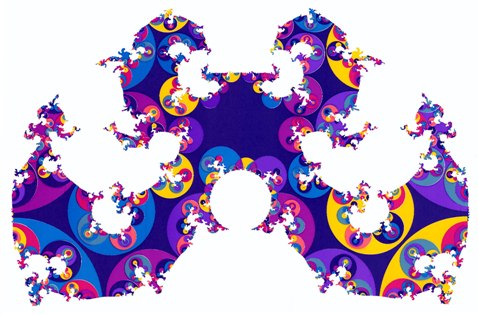
FIG. 1(a) full size image
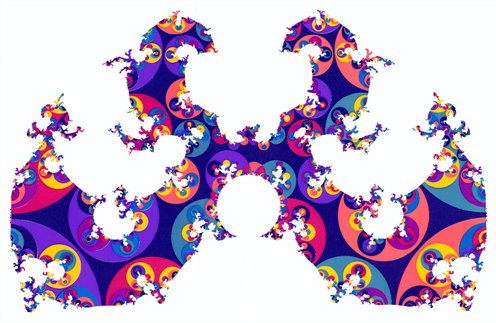
FIG. 1(a, addendum) full size image
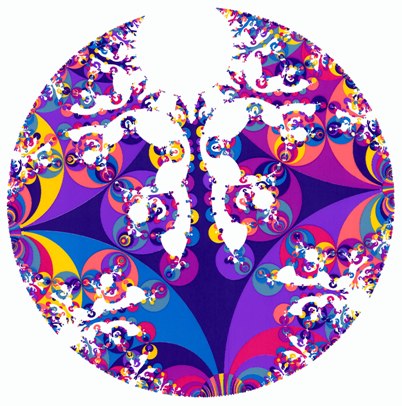
FIG. 1(b) full size image
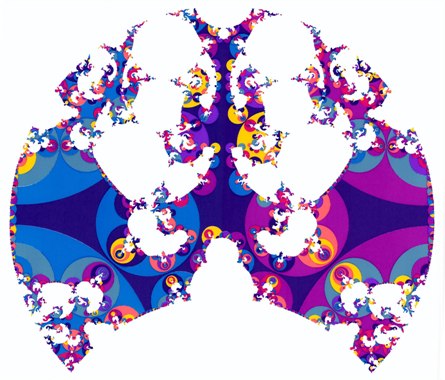
FIG. 1(c) full size image
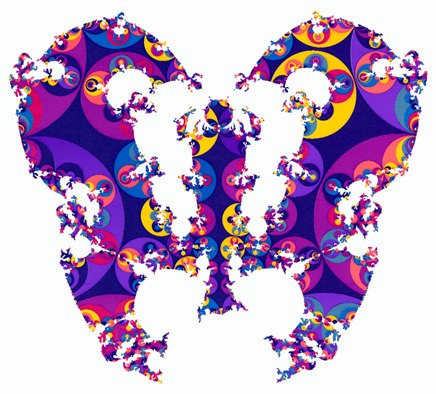
FIG. 1(d) full size image
FIG. 1.(a)–(d) Tilings induced on the boundary S∞ of the universal covering space B3 of the spacelike slices I × S, t = const., by the polyhedral tesselation of B3 (cf. Secs. II and III). The images are stereographic projections of S∞, the sphere at infinity of the Poincaré ball B3, onto the complex plane. Only the component of the tiling on the inside of the quasi-self-similar21 Jordan curve Λ(Γ), which is homeomorphic to a circle, has been drawn. The large black domain, say f, is one of the boundary surfaces of three-space I × S. The tiling of S∞ is performed generation by generation by applying the covering group Γ to f. The tiles are the boundary components of isometric images of I × S, which accumulate at Λ(Γ). From the limit set Λ(Γ), the covering geodesics of the bounded trajectories emanate, and its Hausdorff measure and dimension δ determine a unique localized wave field of the wave equation on the four-dimensional manifold R+ × I × S. The tilings (a)–(d) correspond to non-isometric manifolds of the same topological structure I × S, I a finite open interval, S a Riemann surface, g(S) = 19; δ(a) = 1.386, δ(b) = 1.393, δ(c) = 1.381, δ(d) = 1.452.
description: Roman Tomaschitz (1991) Relativistic quantum chaos in Robertson-Walker cosmologies, Journal of Mathematical Physics 32, 2571.
Keywords: relativistic chaos, open Robertson–Walker universe with multiply connected hyperbolic 3-space, constant negative curvature, Laplace–Beltrami operator and Klein–Gordon equation on open hyperbolic 3-manifolds, energy–momentum tensor of scalar quantum fields, Poincaré half-space, polyhedral tessellation of hyperbolic space, universal covering projection, fractal limit set of a Kleinian covering group, quasi-Fuchsian groups, fibered hyperbolic 3-manifolds, compact Riemann surfaces, quasi-self-similar Jordan curves, Hausdorff measure and dimension of fractal limit sets, hyperbolic convex hull of a limit set, chaotic world lines, Bernoulli property, mixing in the chaotic nucleus of the open 3-space, cosmic time evolution of chaotic trajectories and wave fields, ground state energy of scalar quantum fields on open hyperbolic 3-manifolds, localized ground-state wave function, Poisson kernel
download full-text article (scanned PDF, 3.3 MB)